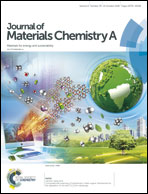Towards high areal capacitance, rate capability, and tailorable supercapacitors: Co3O4@polypyrrole core–shell nanorod bundle array electrodes†
Abstract
Flexible supercapacitors with high areal capacitance are a promising approach for wearable energy-storage technology due to the limitation of the surface area of the human body (about 2 m2). Meanwhile, a tolerance to deformation and mechanic damage is critical for wearable applications. However, it is still a challenge to achieve supercapacitors with outstanding electrochemical performance and wearability, simultaneously. To solve this problem, we report high-performance, flexible, and tailorable solid-state supercapacitors enabled by Co3O4@PPy nanorod bundle arrays immobilized on carbon fiber cloth (CFC). Furthermore, a solid-state asymmetric supercapacitor was assembled using a freestanding Co3O4@PPy electrode, a freestanding porous carbon electrode, and PVA gel electrolyte. Benefiting from a 3D structure and the synergetic contribution of the Co3O4 nanorods and electrically conductive PPy layer, the Co3O4@PPy electrode and our developed supercapacitor exhibit a high areal capacitance of 6.67 F cm−2 at a current density of 2 mA cm−2, and 2.47 F cm−2 at 4 mA cm−2, respectively, as well as excellent rate capability. More importantly, the solid-state supercapacitor can be tailored into several units and various shapes. Each unit retains its original electrochemical performance. This work provides a new route to wearable energy-storage technology.



 Please wait while we load your content...
Please wait while we load your content...